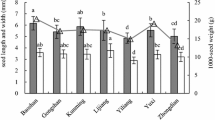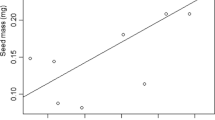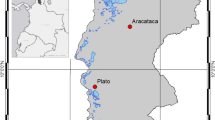Abstract
Turkish red pine (Pinus brutia Ten.), an important pine species for afforestation studies, grows at a wide range of altitudes in the eastern Mediterranean area. Seeds from low (0–400 m a.s.l.), mid (400–800 m) and high (800–1000 m) altitudinal gradients were collected to assess the effects of these gradients on morphological traits (seed length, seed width, 100-seed weight), germination variables (germination percentage and mean germination time), and 10 biochemical variables related to seed reserves. Relationships among these variables were examined with a correlation analysis. Seeds from low and high altitudes had significantly higher 100-seed weight, higher percentage germination but longer germination times and higher total oil and reducing sugars contents. Seeds from mid altitudes had higher carotenoid and soluble phenolics contents. Among the examined biochemical variables, only flavonoid content did not differ among the altitude gradients. The main fatty acids in seeds samples (linoleic, oleic, palmitic and stearic acids) were also influenced by the altitude gradients. Oil and total reducing sugars contents were positively correlated with germination percentage, and carotenoid content was negatively correlated with germination percentage. Our results confirmed that seed and germination variables, including the reserve composition varied significantly among the altitudinal gradients.



Similar content being viewed by others
References
AOAC (1984) Official methods of analysis. Association of Official Analytical Chemists Press, Washington DC, p 800
Ayan S, Erkan C, Gülseven O, Akın ŞS, Yılmaz E, Çelik ENY (2019) Effects of high heat shocks on seed germination in Turkish Red Pine (Pinus brutia Ten) populations. Turk J Agric for 20(4):312–316
Backer H, Frank O, DeAngelis B, Feingold S (1980) Plasma tocopherol in man at various times after ingesting free or acetylaned tocopherol. Nutr Rep Int 21(4):531–536
Bagci E, Karaagacli Y (2004) Fatty acid and tocochromanol patterns of Turkish pines. Acta Biol Crac Ser Bot 46:95–100
Bond BJ, Czarnomski NM, Cooper C, Day ME, Greenwood MS (2007) Developmental decline in height growth in Douglas-fir. Tree Physiol 27(3):441–453
Boydak M, Dirik H, Çalıkoğlu M (2006) Kızılçamın (Pinus brutia Ten) biyolojisi ve silvikültürü. Ormancılığı Geliştirme ve Orman Yangınları ile Mücadele Hizmetlerini Destekleme Vakfı (OGEM-VAK) Press, Turkey
Cai ZQ, Jiao DY, Tang SX, Dao XS, Lei YB, Cai CT (2012) Leaf photosynthesis, growth, and seed chemicals of Sacha Inchi plants cultivated along an altitude gradient. Crop Sci 52(4):1859–1867
Çetin B, Boydak M (2013) The effect of heating process on Turkish Red Pine (Pinus brutia Ten) seeds. Düzce Univer J For 9(1):43–54
Chaisurisri K, Edwards DGW, El-Kassaby YQ (1992) Genetic control of seed size and germination in Sitka spruce. Silvae Genet 41(6):348–355
Correia I, Santos L, Faria C, Nóbrega C, Almeida H, David T (2014) Cone to seedling-variation between Pinus pinaster provenances from contrasting altitudes. For Sci 60(4):724–732
Dangasuk OG, Panetsos KP (2004) Altitudinal and longitudinal variations in Pinus brutia (Ten) of Crete Island, Greece: some needle, cone and seed traits under natural habitats. New for 27(3):269–284
Donohue K, Rubio de Casas R, Burghardt L, Kovach K, Willis CG (2010) Germination, postgermination adaptation, and species ecological ranges. Annu Rev Ecol Evol Syst 41:293–319
DuBois M, Gilles KA, Hamilton JK, Rebers PA, Smith F (1956) Colorimetric method for determination of sugars and related substances. Anal Chem 28(3):350–356
Erbaş S, Tonguç M, Karakurt Y, Şanli A (2016) Mobilization of seed reserves during germination and early seedling growth of two sunflower cultivars. J Appl Bot Food Qual 89:217–222
Folin O, Ciocalteu V (1927) On tyrosine and tryptophane determination in proteins. J Biol Chem 73(2):627–650
Hartree EF (1972) Determination of protein: a modification of the Lowry method that gives a linear photometric response. Anal Biochem 48(2):422–427
Howitt CA, Pogson BJ (2006) Carotenoid accumulation and function in seeds and non-green tissues. Plant Cell Environ 29(3):435–445
Ibanez VN, Berli FJ, Masuelli RW, Bottini RA, Marfil CF (2017) Influence of altitude and enhanced ultraviolet-B radiation on tuber production, seed viability, leaf pigments and morphology in the wild potato species Solanum kurtzianum Bitter & Wittm collected from an elevational gradient. Plant Sci 261:60–68
Işık K, Kara N (1997) Altitudinal variation in Pinus brutia Ten and its implication in genetic conservation and seed transfers in southern Turkey. Silvae Genet 46(2):113–120
Işık K (1986) Altitudinal variation in Pinus brutia Ten: Seed and seedling characteristics. Silvae Genet 35(2–3):58–66
ISTA (2009) International rules for seed testing. International Seed Testing Association Press, Bassersdorf
Izquierdo N, Aguirrezábal L, Andrade F, Pereyra V (2002) Night temperature affects fatty acid composition in sunflower oil depending on the hybrid and the phenological stage. Field Crops Res 77(2–3):115–126
Kadri N, Khettal B, Aid Y, Kherfellah S, Sobhi W, Barragan-Montero V (2015) Some physicochemical characteristics of pinus (Pinus halepensis Mill., Pinus pinea L., Pinus pinaster and Pinus canariensis) seeds from North Algeria, their lipid profiles and volatile contents. Food Chem 188:184–192
Kurt Y, González-Martínez SC, Alía R, Isik K (2012) Genetic differentiation in Pinus brutia Ten using molecular markers and quantitative traits: the role of altitude. Ann For Sci 69(3):345–351
Latowski D, Kuczyńska P, Strzałka K (2011) Xanthophyll cycle-a mechanism protecting plants against oxidative stress. Redox Rep 16(2):78–90
Marquard R (1987) Qualitätsanalytik im Dienste der Ölpflanzenzüchtung. Eur J Lipid Sci Technol 89(3):95–99
Mierziak J, Kostyn K, Kulma A (2014) Flavonoids as important molecules of plant interactions with the environment. Molecules 19(10):16240–16265
Nasri N, Triki S (2004) Analyse des lipides des graines de pins de Tunisie (Pinus halepensis Mill. et Pinus pinea L). Riv Ital Sostanze Gr 81(4):244–247
Oliver PAT, Borja MEL (2010) Seed mass variation, germination time and seedling performance in a population of Pinus nigra subsp. salzamannii. For Syst 19(3):344–353
Parker WC, Noland TL, Morneault AE (2006) The effects of seed mass on germination, seedling emergence, and early seedling growth of eastern white pine (Pinus strobus L). New for 32(1):33–49
Peichl M, Arain MA (2006) Above and below ground ecosystem biomass and carbon pools in an age-sequence of temperate pine plantation forests. Agric for Meteorol 140(1–4):51–63
Sakanaka S, Tachibana Y, Okada Y (2005) Preparation and antioxidant properties of extracts of Japanese persimmon leaf tea (kakinoha-cha). Food Chem 89(4):569–575
Sano N, Rajjou L, North HM, Debeaujon I, Marion-Poll A, Seo M (2016) Staying alive: molecular aspects of seed longevity. Plant Cell Physiol 57(4):660–674
Somogyi M (1952) Notes on sugar determination. J Biol Chem 195:19–23
Sorensen FC, Campbell RK (1993) Seed weight-seedling size correlation in coastal Douglas-fir: genetic and environmental components. Can J for Res 23(2):275–285
Soriano D, Orozco-Segovia A, Márquez-Guzmán J, Kitajima K, Gamboa-de Buen A, Huante P (2011) Seed reserve composition in 19 tree species of a tropical deciduous forest in Mexico and its relationship to seed germination and seedling growth. Ann Bot 107(6):939–951
Tilki F, Dirik H (2007) Seed germination of three provenances of Pinus brutia (Ten) as influenced by stratification, temperature and water stress. J Environ Biol 28(1):133–136
Tonguç F, Tonguç M, Önder S (2020) Changes in protein and sugar contents during the germination period of Turkish red pine (Pinus brutia Ten). J Archit Eng 2(1):23–29
Turfan N, Alay M, Sariyildiz T (2018) Effect of tree age on chemical compounds of ancient Anatolian black pine (Pinus nigra subsp. pallasiana) needles in Northwest Turkey. Forest Bio for 11(3):406–410
Wahid N, Bounoua L (2013) The relationship between seed weight, germination and biochemical reserves of maritime pine (Pinus pinaster Ait) in Morocco. New for 44(3):385–397
Wennström U, Bergsten U, Nilsson JE (2002) Effects of seed weight and seed type on early seedling growth of Pinus sylvestris under harsh and optimal conditions. Scand J for Res 17(2):118–130
Yılmaz M, Kaplan A, Vermez Y (2013) Some seed characteristics of three extreme populations of Turkish Red Pine (Pinus brutia Ten). KSU J Agric Nat 16(1):55–61
Zhao M, Zhang H, Yan H, Qiu L, Baskin CC (2018) Mobilization and role of starch, protein, and fat reserves during seed germination of six wild grassland species. Front Plant Sci 9:234
Acknowledgements
We thank the forest management service of Kumluca (Antalya) for providing P. brutia seed samples and information on the locations. Sercan Önder was financially supported by Council of Higher Education under YÖK 100/2000 fellowship program for graduate students.
Author information
Authors and Affiliations
Contributions
Muhammet Tonguç: designed the study, carried out the experiments, analyzed the data; Sercan Önder: carried out the experiments, analyzed the data, generated the illustrations; Nesrin Gülcemal: carried out the experiments; Fatih Tonguç: designed the study, carried out the experiments.
Corresponding author
Additional information
Publisher's Note
Springer Nature remains neutral with regard to jurisdictional claims in published maps and institutional affiliations.
Project Funding: This work was supported by Scientific and Technological Research Council of Turkey (TUBITAK) (Grant number 2209-A).
The online version is available at http://www.springerlink.com.
Corresponding editor: Yanbo Hu.
Rights and permissions
About this article
Cite this article
Tonguç, M., Önder, S., Gülcemal, N. et al. Seed, germination, and seed-reserve traits differ along an altitudinal gradient. J. For. Res. 33, 1903–1912 (2022). https://doi.org/10.1007/s11676-022-01467-4
Received:
Accepted:
Published:
Issue Date:
DOI: https://doi.org/10.1007/s11676-022-01467-4




